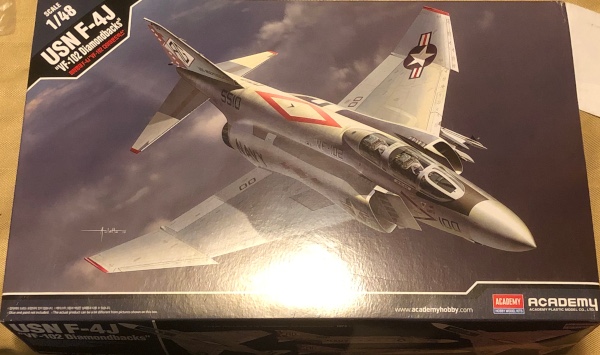
Academy 1/48 USN F-4J "VF-102 Diamondbacks"
By Jacob Russell
The Plane
The McDonnell F-4J Phantom followed the Navy's F-4B and incorporated many of the structural changes and systems found in United States Air Force Phantoms. These changes included strengthened landing gear and wider tires, resulting in bulges on both the upper and lower wings to accommodate them.

|
The F-4J was powered by a pair of the uprated General Electric J79-GE-10 jet engine, rated at 17,900 lbs of thrust. It also had slotted stabilators which reduced landing speed by nearly 12 knots and it retained the F-4B's shut leading edge flap innermost section. The armament remained 4 AIM-7 Sparrow and 4 AIM-9 Sidewinder missiles.
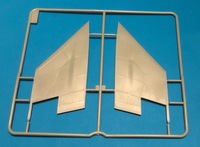
|
The electronics were upgraded. The AN/AWG-10, an all new missile control and radar system, was installed. The AN/AWG-10 incorporated the AN/AWG-59 radar which used the same radar dish as the F-4B so the radome retained it's size and shape, although the infra-red seeker and its fairing were removed from under the nose.
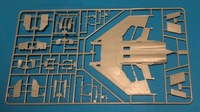
|
Updates included the AJB-7 bombing system, the AN/APR-32 RHAW Electronic Countermeasures (ECM) system. The antennas of the latter system were mounted in the fairing on top of the fin and under the nose. Martin-Baker supplied the Mk. 7 ejection seats with the "zero-zero" feature.

|
The F-4J first flew on May 27, 1966 with deliveries beginning in June of that year. The first production aircraft reached the fleet on December 27, 1966. McDonnell built 522 F-4J Phantoms for the United States Navy between June of 1966 and January 7th of 1972.
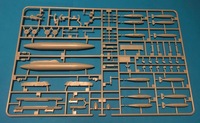
|
The Model
This is a big box, full of lots of parts for a kit of a big aircraft. The box art is well done, depicting an F-4J climbing gracefully. Academy's F-4J kit consists of 413 parts on 14 sprues plus the fuselage. You have 80 parts that aren't intended for this Phantom variant, so they are destined for your spares box. This is a nice kit. Surface detail on the fuselage consists of finely recessed panel lines plus some good rivet detail where appropriate. The upper and lower wings have a similar finesse.
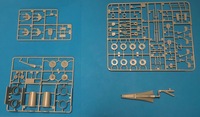
|
The upper wing bulges are well executed. These bulges are so subtle, which explains why I was unable to see them in black and white pictures. The parts are well molded, with minimal flash and well located parts attachment points which will make them easy to detach without damage. There are some ejector pin marks on some of the parts but most are these are either hidden or they will be fairly easy to fill.
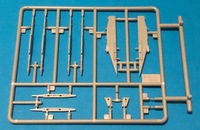
|
The beefed up landing gear and larger tires look good. They lack the finesse and quality of Eduard and Hasegawa, but with the addition of some brake lines and an oil wash they will look pretty good. The wheel wells are multi-piece assemblies that will look very impressive with the addition of wires, hoses and an oil wash. The clear parts are well executed. They are thin and distortion free.
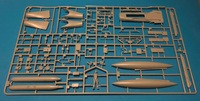
|
The cockpit has a lot of pieces, complete with a pair of pilot figures. If you have every wanted to try your hand at painting figures this is your chance. You get 2 heads for each figure, one with the oxygen mask and one without. If you're unhappy with your paint work on one head, just use the other. If you dispense with the figures altogether you might want to purchase a pair of resin aftermarket seats.
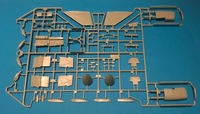
|
The kit parts aren't bad, but they don't measure up to the level of detail and finesse of resin ejection seats from Quickboost and others. The instrument panels and sidewall consoles aren't bad. They will come up nicely with an oil wash and dry brush but the instrument faces are blank. Once again, the aftermarket comes to the rescue with instrument panel decals available from Airscale. Before I forget, there is also a standing pilot figure but I would replace his head as his face looks goofy and somewhat bemused rather than confident.
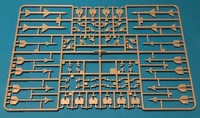
|
The jet intakes and afterburner cans look pretty good. Phantoms are noted for the extensive discolored metal areas under the tail planes. You can go to town here with the metalizer paints of your choice. Have fun!
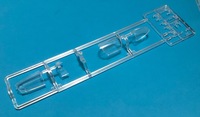
|
The under wing stores are comprehensive. They include a 600 gallon center line tank, 370 wing tanks, and a host of armament. You also get the aforementioned AIM-7 Sparrow and AIM-9 Sidewinder missiles, and Mk. 82 general purpose bombs.
The decal sheet is by Cartograph of Italy. It is superb: crisply printed, with excellent colors and registration. It includes 2 decal options for a single F-4J at 2 stages of its career:
F-4J, BuNo. 155510, AG100, VF-102 "Diamondbacks", USS Independence (CV-64), 1973. This plane was Light Gull Gray over white. The nose, rudder, flaps, and outer tail planes were white. The wing and tail plane tips were red.
F-4J, BuNo. 155510, AG100, VF-102 "Diamondbacks", USS Independence (CV-64), 1976. The plane is painted the same as above: Light Gull Gray over white, minus the wing and fuselage wing walks. They were deleted, along with the red tips on the wing and tail planes.

|
I particularly like Academy's approach to kit instructions. They are divided into 3 sections for this kit: Manual One (main instructions), Manual Two (armament load-out instructions), and Manual Three, a full color decal placement guide. Manual Three includes a separate guide for the airframe stencils, national insignias, etc. plus 2 color profiles. Manual One includes a parts map and color call outs for Humbrol (enamels and acrylics), GSI Creos/Gunze (acrylics and lacquers), Lifecolor, Testors/Modelmaster (enamels and acrylics), Revell (enamels and acrylics) and Vallejo (Model Color and Model Air). The instructions are well laid out and well illustrated. They have a logical and clear build sequence.
Conclusion
This a good kit. It gives up some detail to Hasegawa's Phantom kits, but an adept, patient modeler can get an excellent result from it. Look to the aftermarket for more detailed ejection seats, wheels and instrument panel decals. The paint scheme's simplicity gives you the opportunity to hone your weathering skills, and you can practice your metal finishing techniques on the afterburners and the aft fuselage. I recommend this kit and I would like to thank Model Rectifier Corporation for the review sample.
References
F-4 Phantom in action, Aircraft Number 65, by Larry Davis, Squadron
https://www.militaryfactory.com/aircraft/detail.asp?aircraft_id=24
